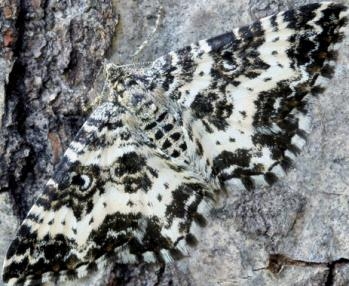
Butterfly.conservation.org. Argent and sable moth.
Osprey family in the roost tree at Foulshaw Moss Nature Reserve in 2015 © Ian Alexander Waite

Butterfly.conservation.org. Argent and sable moth.
Upon starting my placement with the Cumbria Wildlife Trust, I became heavily involved with the nature reserves team, and in particular with Foulshaw Moss Nature Reserve.
On my very first day, I met with a representative from Butterfly Conservation, who was conducting a study into argent and sable moths (Rheumaptera hastata) on the reserve – asking if I would be interested in helping with her research.
Argent and Sable moths, of the Geometridae family, are unusual amongst moths as they are day flying. These moths were once widespread across the UK; however, this is no longer the case. In 2004 there were only 14 sites supporting the moth on mainland Britain, according to Butterfly Conservation. Its previous range was prominently wetlands and hillsides, making the Lake District seemingly a perfect habitat.
Foulshaw Moss has several historical recorded sightings of these elusive moths. Due to their day flying nature, classical light traps are largely useless for capturing this species; meaning the use of pheromone traps has been necessary. In theory, a pheromone moth trap will release the pheromone that a fertile female moth releases, luring male moths into a safe container where they can be identified. Traps like these were placed around the Foulshaw Moss Nature Reserve.
My job was to check the moth traps once per day at 12 pm, record my observations on the contents of the traps as well as the weather conditions, and rotate them clockwise around their designated positions.
The traps were in place between the 1st of June and the 13th of June but were taken down on the 14th. During the time they were in place, no argent and sable moths were caught by the pheromone traps, however, on the rest of the site, there have been 3 confirmed sightings. The data I collected was then forwarded to Butterfly Conservation where it will hopefully aid in the restoration of this rare moth.
While not dealing with the moth project, my main responsibility was the observation and recording of the resident ospreys on Foulshaw Moss. Blue 35 (female) and White YW (male) and I actually crossed paths in mid-air! As I was flying to The Gambia with my university at the end of March, they would be flying from The Gambia to the UK. Their first eggs were laid on the 14th April 2017, with their estimated hatching occurring between the 20th and 25th of May.
It was soon after this I joined Cumbria Wildlife Trust on my placement and saw the chicks for the first time when they were approx. 2 weeks old – they could almost be mistaken for sock puppets sticking above the rim of the nest.
James Barclay. Osprey chicks in nest 2017
Now another 3 weeks on, it’s time to ring the chicks, where they look more like a fully grown bird than a chick.
Keep watching for the next blog on the ringing of our chicks.
James
About the author
James is a student placement gaining experience in wildlife conservation alongside Foulshaw Moss Nature Reserve Officer, Paul Waterhouse.